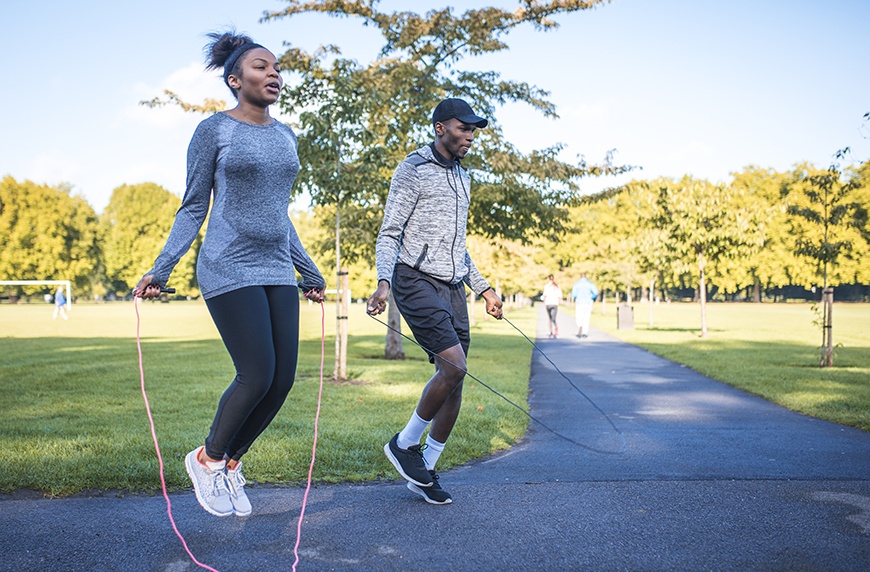A Beginner’s Guide to Building Stamina and Boosting Your Endurance
Why? For starters, improving your physical fitness involves increasing your body’s efficiency. And stamina is key to maximizing the productivity of your heart, lungs, and muscles.
So stamina is important, but what is it, exactly?
Stamina, which can be used to describe both physical and mental pursuits, is defined as the ability to push yourself to your maximum potential for a given length of time. When you set out to build your stamina, you’re working to increase the period of time during which you’re able to perform at the peak of your abilities. Stamina differs from endurance in that the latter is actually about increasing the duration of your workout not maxing out your effort, necessarily.

Benefits of increasing stamina
Let’s be real for a minute—even performing at your current ability level can be completely draining. And now you’re expected to kick things up a notch?! I can hear a collective groan echoing through the internet, and trust me, I know that the struggle is real. But before you say “no way” to pushing your body even harder than you already do, consider that there are several important benefits involved in building stamina.
Increased stamina means reduced fatigue, less energy required to complete your daily to-do list, and better physical and mental health and well-being. The evidence all points overwhelmingly toward the importance of increasing stamina, regardless of your current abilities.
How to make it easier to build stamina
If you’re ready to throw in the towel before you even get started building stamina, there are mental techniques you can use to keep your head in the game. Rachel Gargiulo, a certified nutrition consultant at Nourishing Journey in Columbia, Maryland, says, “When aiming to build stamina, practicing mindfulness meditation is an effective tool to help manifest a positive mindset around pushing through discomforts and boredom. Through this increased presence of mind that you'll achieve, you can then work on telling yourself not to complain and to keep going when the circumstances are trying."

A beginner's guide to increasing physical stamina
Okay, so if you're convinced to get to work on building your stamina, the next question is where to start. Don’t sweat it—I’ve got you covered with some stamina-boosting strategies. Use these suggestions as a guide, but also listen closely to your body’s cues. If you aren’t sure how hard to push, don’t be afraid to reach out to your physician or a certified personal trainer for help coming up with your game plan.

{{post.sponsorText}}
1. Improve your aerobic capacity with interval training
Interval training may sound like an advanced technique, but it’s literally nothing more than alternating short bursts of high-intensity activity and longer periods of lower intensity activity. The high-and-low-intensity levels are individualized based on your current state of fitness. So if jogging is your jam, you can add short, intense sprints to your regular routine; if you’re more of a speed walker, you can switch between walking at your typical pace and short periods of jogging.
There are multiple methods for interval training, from HIIT to HILIT, but you can just start with this basic formula: 30-second bursts of high-intensity activity followed by three to four minutes of lower intensity exercise. This program will help you build stamina by improving your aerobic capacity, which in turn will help increase the duration and intensity of your workouts.
2. Incorporate strength training in your cardio routine
If you want to be able to go harder for longer, you have to build the muscles that will make that possible. Strength training challenges your cardiovascular system and helps increase your running economy, which allows you to use energy more efficiently as you exercise.
Instead of building your exercise program around cardio alone, be sure to work in strength training with free weights, machines, or movement sequences that incorporate both cardio and strength. For example, try a minute of jumping jacks to get your heart pumping followed by 20 push-ups to strengthen your core. Increasing the tension on an exercise bike is an excellent way to combine cardio and strength training, and swimming is an underrated exercise that will work your heart and your upper body muscles.
3. Decrease recovery time between weight lifting sets
Instead of resting for 60 seconds in between weight lifting sets, try resting for 30 seconds; eventually, see if you can eliminate the break between sets entirely. If you find this too challenging, consider lifting less weight and increasing the number of reps, which is a perfect recipe for stamina and endurance.
4. Gradually increase the duration of your workouts
If you want to teach your body to put forth physical effort for longer periods of time, you have to get it accustomed to that task. Start by increasing the duration of one of your workouts once a week. Build on your exercise duration gradually, even if it means taking your intensity down a notch during that workout. Once you’ve increased your endurance, speed and intensity will follow.
5. Schedule an ultra-intense workout once a week
One of the keys to building stamina is increasing your body’s capabilities. One way to improve your cardiovascular fitness is to get your heart and muscles used to intense physical activity. The tempo of your workout should be challenging but not impossible. The best part of this strategy is that it will make your lower intensity workouts feel much easier in comparison.
6. Allow your body time to rest and recover
Your new stamina-building plan is going to involve a shift in the pace of your typical routine. If you don’t give your muscles enough opportunity to recover, your performance is sure to suffer due to fatigue and overuse. Recovery involves scheduling rest days off from training, eating a healthy and balanced diet, getting enough sleep, and stretching daily to promote muscular health.
Most importantly, you must remember that boosting physical stamina requires mental stamina, focus, and discipline, too. Your mind can push your body to go a bit beyond its comfort zone, but your mind can also fail you if you let it convince you to stop short. As long as your goals are realistic and doctor-approved, you should be sure to work on your mental stamina through positive affirmations and self-talk, visualizations, and even reframing your training goals in a way that feels more manageable. Someday soon, your hardest workouts are going to be your new easy, and you’ll have your highly increased stamina to thank for that!
Oh hi! You look like someone who loves free workouts, discounts for cult-fave wellness brands, and exclusive Well+Good content. Sign up for Well+, our online community of wellness insiders, and unlock your rewards instantly.
Loading More Posts...